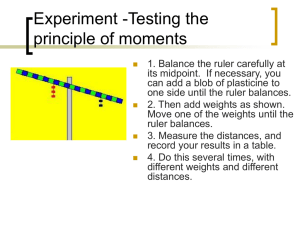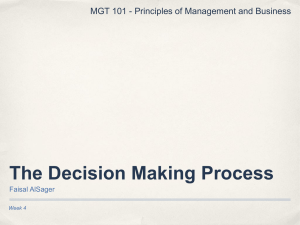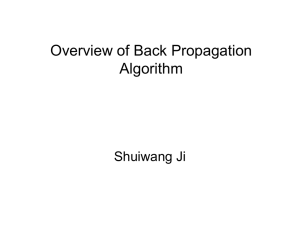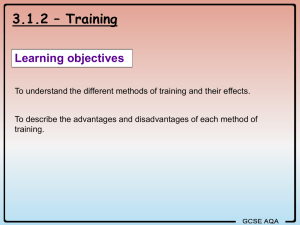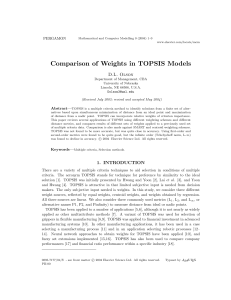Weights of Critical Success Factors
advertisement
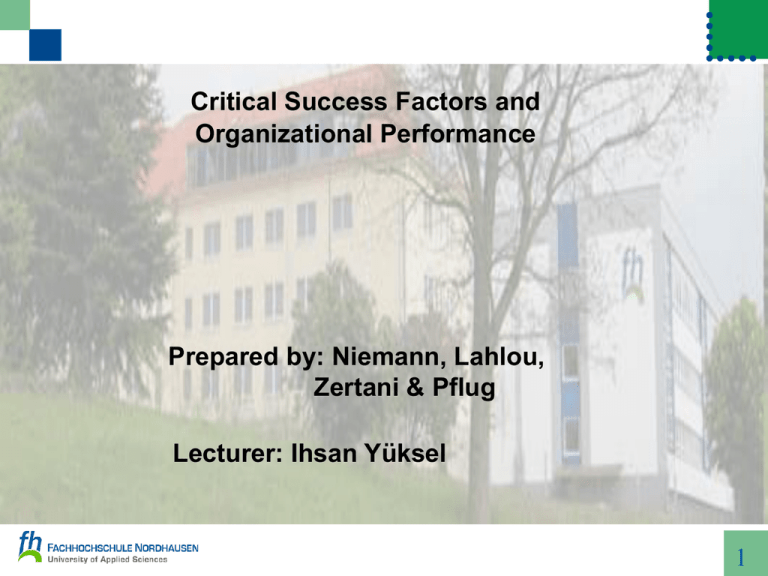
Critical Success Factors and Organizational Performance Prepared by: Niemann, Lahlou, Zertani & Pflug Lecturer: Ihsan Yüksel 1 Introduction • In this project, critical success factors approach will be used in measurement of organizational performance. • Performance: output/outcome at the end of a certain period of time of an activity. • Outcome: extents the organization reached its objectives. • Performance measurement: evaluation of all efforts made to achieve objectives. 2 • Critical success factors refer: posses to be successful in the industry they work in. Method multi-criteria analysis techniques • Technique for Order Performance by Similarity to Ideal Solution (TOPSIS) – determine ranking of the critical success factors. • Analytical Hierarchy Process (AHP): – calculate the weights of critical success factors. 3 Step 1: Determining the factors that enable the organization to be successful in its sector. In this step, first the factors necessary for the organization to be successful in its sector have been determined. 4 The factors considered for the example organization in the project are as follows: SF1: financing SF2: brand image SF3: effective advertising SF4: pricing SF5: customer satisfaction SF6: distribution skills SF7: managerial ability SF8: consumer loyalty SF9: low product cost 5 Step 2: Ranking of success factors In this step, firstly, the factors that attribute a success factor as “critical” have been determined. Criteria (main factors) which are considered to determine the “critical” of a success factor are as follows: • Strategic character • Create value • Priority of factor 6 In this step secondly, weights of factors had been calculated by the AHP technique. In other words, relative importance has been calculated. Table 1: Scale of relative importance used in the pair-wise comparisons of AHP Comparative judgment Scale of relative importance ai and aj are equally important 1 ai is moderately more important than aj 3 ai is strongly more important than aj 5 ai is very strongly more important than aj 7 ai is extremely more important than aj 9 Intermediate values between two adjacent judgments 2,4,6,8 7 Table 2: The pair-wise matrix of the main factors Main Factors SC CV PF Strategic character (SC) 1,000 4,000 7,000 Create value (CV) 0,2500 1,000 3,000 Priority of factor (PF) 0,143 0,333 1,000 8 • After forming the pair-wise comparison matrix, weights of factors have been calculated. In this project, weights vectors had been determined as follows: Table 3: Weight of Main Factors Main Factors Weight Strategic character (SC) 0,701437 Create value (CV) 0,213238 Priority of factor (PF) 0,085324 9 Calculate consistency of pair-wise comparison matrix • Calculate of consistency ratio (CR) as follows 10 Then consistency vector is formed as follows: 11 n indicates number of factors. The avarage value ( ) of the elements in the consistency vector is: λmax = 9,09807÷3 = 3,032576 The consistency index (CI) have been calculated using the following formula: 12 Depending on n number of factors, random index (RI) had been determined. Random index obtained from the Table 4. For this example RI is 0,58. Table 4: Average random consistency (RI) Size of Matrix 2 3 4 5 6 7 8 9 Random consistency 0 0,58 0,9 1,12 1,24 1,32 1,41 1,45 13 • Consistency ratio (CR) • CR is smaller than 0.10 pair-wise comparison matrix is consistent. 14 Ranking: • After calculating weight of the main factors, ranking of the success factors have been determined using TOPSIS technique. • The calculations have been made in Excel program. 15 Each success factor has been evaluated a number between 1-10. And, each column (SC, CV, PF) have been summed (Table 5). Table 5: Factor Evaluation SC 0,701437 CV 0,213238 PF 0,085324 SF1 6 4 3 SF2 5 5 5 SF3 3 7 7 SF4 4 3 3 SF5 2 7 4 SF6 6 8 2 SF7 5 2 5 SF8 7 1 6 SF9 8 7 3 Total value 46 44 38 FACTORS 16 • Normalized matrix Table 6: Normalized Matrix FACTORS SC CV PF SF1 0,1304 0,0909 0,0789 SF2 0,1087 0,1136 0,1316 SF3 0,0652 0,1591 0,1842 SF4 0,0870 0,0682 0,0789 SF5 0,0435 0,1591 0,1053 SF6 0,1304 0,1818 0,0526 SF7 0,1087 0,0455 0,1316 SF8 0,1522 0,0227 0,1579 SF9 0,1739 0,1591 0,0789 17 Normalized matrix and the vector of main factor weights have been multiplied. x 18 Table 7: Ranking of Success Factors with TOPSIS Success Factors Importance Ranking SF01 0,103729 6 SF02 0,116146 4 SF03 0,127821 3 SF04 0,078383 9 SF05 0,099389 7 SF06 0,128968 2 SF07 0,092282 8 SF08 0,108298 5 SF09 0,144984 1 According ranking of success factors is as follows : First factor is SF09, second is SFO6 and third is SF03 etc. 19 Step 3: Determining threshold value for determining critical success factors At this step, a threshold value had been determined so that critical success factors have been selected from above in Table 7. In this project threshold value was accepted 0.10 According to this value, these factors are: • • • • • • SF01 SF02 SF03 SF06 SF08 SF09 20 Step 4: Making pair-wise comparisons of critical success factors and calculation of the weights of critical success factors. Table 8: Pair-wise Comparison Matrix of the Critical Success Factors SF09 SF06 SF03 SF02 SF08 SF01 SF09 1,000 1 ,000 2 ,000 3 ,000 4,000 5,000 SF06 1,000 1,000 2,000 4,000 8,000 7,000 SF03 0,500 0,500 1,000 3,000 1,000 4,000 SF02 0,333 0,250 0,333 1,000 2,000 5,000 SF08 0,250 0,125 1,000 0,500 1,000 7,000 SF01 0,200 0,143 0,250 0,200 0,143 1,000 21 • Calculated factor weights are as follows (Table 9). Table 9: Weights of Critical Success Factors Weights SF09 0,26939 SF06 0,336427 SF03 0,154359 SF02 0,102796 SF08 0,102587 SF01 0,034442 22 Step 5: Determining organizational performance At this step, performance of the organization has been calculated using critical success factors weights (Table 9) and evaluation scale (Table 10) that provide in the literature. Table 10: Level of Factors Level of factors Value Very Good (VG) 1.0 Good (G) 0.8 Medium (A) 0.6 Negative (N) 0.4 Very Negative (VN) 0.2 Not Evaluation (NE) 0.0 23 Table 11: Determining Performance Level According to Critical Success Factors Factor weights Level of factor Financing 0,034442 Good 0,8 0,027554 Brand image 0,102796 Very good 1,0 0,102796 Effective advertising 0,154359 Good 0,8 0,123487 Distribution skills 0,336427 Medium 0,6 0,201856 Consumer loyalty 0,102587 Good 0,8 0,08207 Low production cost 0,26939 Very good 1,0 0,26939 Critical success factors SF1 SF2 SF3 SF6 SF8 SF9 Total Performance Level Value Performance level 0,807153 24 There are five columns in Table 11. • The first column: critical success factors; • the second column: weight of critical success factors; • the third column: evaluation level of each factor; • the fourth column: numerical equivalent of the evaluation level and • the fifth column: performance level of each critical success factor. • calculation: factor weight and scale value had been multiplied. 25 • In the last row, general performance level had been determined, • The sum of performance level of each factor in fifth column was yielded general performance, • This value takes a value between 0 and 1, • If the value of the general performance level is close to 1, it means that organizational performance is excellent 26 • If the general performance level value is close to 0, this means that organizational performance is very bad, • Of course, the decision and evaluation of organization management are also important, • In other words, whether the level is considered sufficient or insufficient depends on the organizational management. 27 References Caralli,R.A., 2004, The Critical Success Factor Method: Establishing a Foundation for Enterprise Security Management Technical Report. Chow, T., Cao, D-C., 20007, A survey study of critical success factors in agile software projects, The Journal of Systems and Software. Dağdeviren et al., 2009, Weapon selection using the AHP and TOPSIS methods under fuzzy environment, Expert Systems with Applications, 36(4), 8143-8151. Daniel, D. R, 1961, Management Information Crisis, Harvard Business Review. Hussey, D., (1998), Strategic Management; 4.ed., Butterwood Heinemann. Hwang, C. L., & Yoon, K.,1981, Multiple attribute decision making: Methods and applications, A State of the Art Survey. New York: Springer-Verlag 28 Leidecker, JK., Bruno, A.V., (1984), “Identifying and using critical success factors”, Long Range Planning, 17, 23-32. Ngai, E.W.T. Law, Wat, C.C.H. F.K.T. 200, Examining the critical success factors in the adoption of enterprise resource planning, Computers ın Industry, 59, 548-564 Park, K.S., Lee, J., 2009, A new method for estimating human error probabilities:AHP-SLIM, Reliability Engineering & System Safety, Rockart, J.F. 1986, A Primer on Critical Success Factors" published in The Rise of Managerial Computing: The Best of the Center for Information Systems Research, edited with Christine V. Bullen. (Homewood, IL: Dow Jones-Irwin), 1981, OR, McGrawHill School Education Group.. Saaty, T.L., 1980, The analytic hierarchy process. New York:McGraw-Hill Inc., Ülgen, H., Mirze, S. K., 2007, İşletmelerde Stratejik Yönetim, Literatür Yayınları, İstanbul. 29
